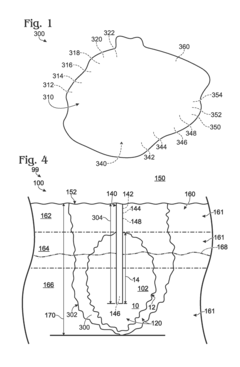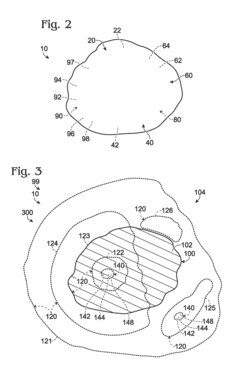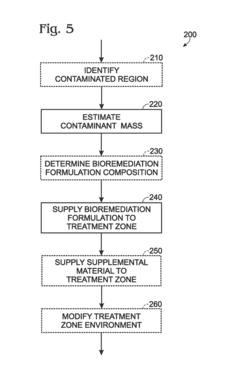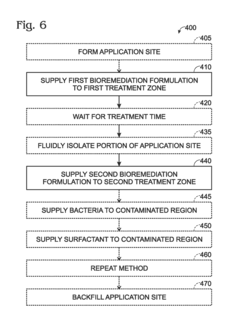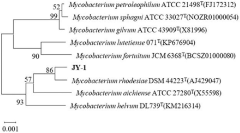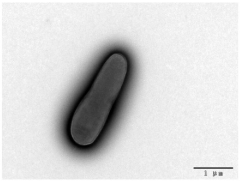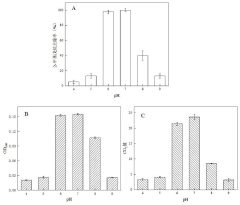Exploring 2-Methylpentane's Potential in Bioremediation Methods
JUL 25, 20259 MIN READ
Generate Your Research Report Instantly with AI Agent
Patsnap Eureka helps you evaluate technical feasibility & market potential.
2-Methylpentane Background and Bioremediation Goals
2-Methylpentane, a branched alkane hydrocarbon, has recently garnered attention in the field of bioremediation due to its potential as an effective solvent and substrate. This compound, with its unique chemical properties, presents an intriguing avenue for addressing environmental contamination issues, particularly in soil and water systems.
The evolution of bioremediation techniques has been driven by the increasing need for sustainable and eco-friendly methods to clean up polluted environments. Traditional remediation approaches often involve harsh chemicals or expensive physical processes, which can have detrimental effects on ecosystems. In contrast, bioremediation harnesses the power of microorganisms to break down or neutralize harmful substances, offering a more natural and less invasive solution.
2-Methylpentane's role in bioremediation is rooted in its molecular structure and behavior. As a branched alkane, it possesses properties that make it both a potential target for biodegradation and a useful tool in the remediation process. Its moderate volatility and solubility characteristics allow it to interact with both soil particles and water, making it versatile in various environmental matrices.
The primary goal of exploring 2-Methylpentane in bioremediation methods is to develop more efficient and targeted approaches for contaminant removal. Researchers aim to understand how this compound can be utilized to enhance the degradation of recalcitrant pollutants, particularly those of similar chemical nature, such as other hydrocarbons found in oil spills or industrial waste.
One of the key objectives is to identify and cultivate microbial strains capable of metabolizing 2-Methylpentane efficiently. This could lead to the development of specialized bacterial consortia that can be deployed in contaminated sites to accelerate the breakdown of complex pollutants. Additionally, there is interest in exploring how 2-Methylpentane might serve as a co-substrate, potentially stimulating the degradation of other, more persistent contaminants.
Another important aspect of this research is to investigate the potential of 2-Methylpentane as a bioaugmentation agent. By introducing this compound into contaminated environments, scientists hope to stimulate the growth and activity of indigenous microorganisms capable of degrading a wider range of pollutants. This approach could lead to more robust and adaptable bioremediation strategies.
The ultimate aim of this technological exploration is to create innovative, cost-effective, and environmentally friendly bioremediation solutions. By leveraging the properties of 2-Methylpentane, researchers aspire to develop methods that can be applied across various scales, from small localized contaminations to large-scale environmental restoration projects. The success of these efforts could significantly impact the field of environmental remediation, offering new tools to address the growing challenges of pollution and environmental degradation.
The evolution of bioremediation techniques has been driven by the increasing need for sustainable and eco-friendly methods to clean up polluted environments. Traditional remediation approaches often involve harsh chemicals or expensive physical processes, which can have detrimental effects on ecosystems. In contrast, bioremediation harnesses the power of microorganisms to break down or neutralize harmful substances, offering a more natural and less invasive solution.
2-Methylpentane's role in bioremediation is rooted in its molecular structure and behavior. As a branched alkane, it possesses properties that make it both a potential target for biodegradation and a useful tool in the remediation process. Its moderate volatility and solubility characteristics allow it to interact with both soil particles and water, making it versatile in various environmental matrices.
The primary goal of exploring 2-Methylpentane in bioremediation methods is to develop more efficient and targeted approaches for contaminant removal. Researchers aim to understand how this compound can be utilized to enhance the degradation of recalcitrant pollutants, particularly those of similar chemical nature, such as other hydrocarbons found in oil spills or industrial waste.
One of the key objectives is to identify and cultivate microbial strains capable of metabolizing 2-Methylpentane efficiently. This could lead to the development of specialized bacterial consortia that can be deployed in contaminated sites to accelerate the breakdown of complex pollutants. Additionally, there is interest in exploring how 2-Methylpentane might serve as a co-substrate, potentially stimulating the degradation of other, more persistent contaminants.
Another important aspect of this research is to investigate the potential of 2-Methylpentane as a bioaugmentation agent. By introducing this compound into contaminated environments, scientists hope to stimulate the growth and activity of indigenous microorganisms capable of degrading a wider range of pollutants. This approach could lead to more robust and adaptable bioremediation strategies.
The ultimate aim of this technological exploration is to create innovative, cost-effective, and environmentally friendly bioremediation solutions. By leveraging the properties of 2-Methylpentane, researchers aspire to develop methods that can be applied across various scales, from small localized contaminations to large-scale environmental restoration projects. The success of these efforts could significantly impact the field of environmental remediation, offering new tools to address the growing challenges of pollution and environmental degradation.
Market Analysis for Bioremediation Solutions
The bioremediation solutions market has been experiencing significant growth in recent years, driven by increasing environmental concerns and stringent regulations regarding pollution control and waste management. The global bioremediation market size was valued at approximately $186.3 billion in 2022 and is projected to expand at a compound annual growth rate (CAGR) of 8.2% from 2023 to 2030. This growth is primarily attributed to the rising awareness of sustainable environmental practices and the need for cost-effective remediation technologies.
The market for bioremediation solutions is segmented based on technology type, including phytoremediation, biostimulation, bioaugmentation, and others. Among these, biostimulation holds the largest market share due to its wide applicability and effectiveness in treating various types of contaminants. The introduction of 2-methylpentane as a potential bioremediation agent could potentially disrupt this market segmentation, offering new opportunities for innovation and market growth.
Geographically, North America dominates the bioremediation market, followed by Europe and Asia-Pacific. The United States, in particular, holds a significant market share due to its stringent environmental regulations and large-scale remediation projects. However, emerging economies in Asia-Pacific, such as China and India, are expected to witness the highest growth rates in the coming years, driven by rapid industrialization and increasing environmental concerns.
Key industries driving the demand for bioremediation solutions include oil & gas, manufacturing, agriculture, and mining. The oil & gas sector, in particular, represents a substantial market opportunity for bioremediation technologies, including potential applications of 2-methylpentane. This is due to the sector's ongoing need for effective remediation of hydrocarbon-contaminated sites.
The market is characterized by the presence of both large multinational corporations and small to medium-sized enterprises. Major players in the bioremediation market include Xylem Inc., Drylet LLC, Suez Environment S.A., and Veolia Environment S.A. These companies are continuously investing in research and development to enhance their product portfolios and maintain their competitive edge.
Customer demand in the bioremediation market is increasingly focused on cost-effective, efficient, and environmentally friendly solutions. The potential introduction of 2-methylpentane-based bioremediation methods could address these market needs, particularly if it demonstrates superior performance in terms of remediation speed, cost-effectiveness, or applicability to a wider range of contaminants compared to existing solutions.
The market for bioremediation solutions is segmented based on technology type, including phytoremediation, biostimulation, bioaugmentation, and others. Among these, biostimulation holds the largest market share due to its wide applicability and effectiveness in treating various types of contaminants. The introduction of 2-methylpentane as a potential bioremediation agent could potentially disrupt this market segmentation, offering new opportunities for innovation and market growth.
Geographically, North America dominates the bioremediation market, followed by Europe and Asia-Pacific. The United States, in particular, holds a significant market share due to its stringent environmental regulations and large-scale remediation projects. However, emerging economies in Asia-Pacific, such as China and India, are expected to witness the highest growth rates in the coming years, driven by rapid industrialization and increasing environmental concerns.
Key industries driving the demand for bioremediation solutions include oil & gas, manufacturing, agriculture, and mining. The oil & gas sector, in particular, represents a substantial market opportunity for bioremediation technologies, including potential applications of 2-methylpentane. This is due to the sector's ongoing need for effective remediation of hydrocarbon-contaminated sites.
The market is characterized by the presence of both large multinational corporations and small to medium-sized enterprises. Major players in the bioremediation market include Xylem Inc., Drylet LLC, Suez Environment S.A., and Veolia Environment S.A. These companies are continuously investing in research and development to enhance their product portfolios and maintain their competitive edge.
Customer demand in the bioremediation market is increasingly focused on cost-effective, efficient, and environmentally friendly solutions. The potential introduction of 2-methylpentane-based bioremediation methods could address these market needs, particularly if it demonstrates superior performance in terms of remediation speed, cost-effectiveness, or applicability to a wider range of contaminants compared to existing solutions.
Current State and Challenges in Bioremediation
Bioremediation has emerged as a promising eco-friendly approach for environmental cleanup, with 2-methylpentane showing potential as a target compound. The current state of bioremediation techniques for 2-methylpentane is characterized by both significant advancements and persistent challenges.
Recent studies have demonstrated the efficacy of certain microbial strains in degrading 2-methylpentane under controlled conditions. Pseudomonas and Rhodococcus species have shown particular promise, with their enzymatic pathways capable of breaking down the compound's molecular structure. However, the application of these findings in real-world scenarios remains limited, primarily due to the complex nature of contaminated environments.
One of the major challenges in 2-methylpentane bioremediation is the compound's low water solubility and high volatility. These properties make it difficult for microorganisms to access and metabolize the contaminant effectively. Researchers are exploring various strategies to overcome this hurdle, including the use of biosurfactants and specialized delivery systems to enhance bioavailability.
Another significant obstacle is the potential toxicity of 2-methylpentane to the very microorganisms intended for its degradation. High concentrations of the compound can inhibit microbial growth and metabolic activities, necessitating the development of more resilient bacterial strains or consortia. Genetic engineering approaches are being investigated to enhance the tolerance and degradation capabilities of promising microbial species.
The scalability of laboratory successes to field applications presents a further challenge. Factors such as soil composition, pH, temperature, and the presence of other contaminants can significantly impact the effectiveness of bioremediation strategies. Researchers are working on developing robust bioremediation systems that can adapt to diverse environmental conditions while maintaining optimal degradation rates.
Regulatory hurdles and public perception also play a role in the current state of 2-methylpentane bioremediation. Stringent environmental regulations and concerns about the use of genetically modified organisms in open environments can slow the adoption of novel bioremediation techniques. Addressing these issues requires a multidisciplinary approach, combining scientific advancements with policy development and public education initiatives.
Despite these challenges, the field of 2-methylpentane bioremediation continues to advance. Innovative approaches, such as the integration of nanotechnology and the development of immobilized enzyme systems, show promise in overcoming some of the current limitations. Additionally, the application of metagenomic and metabolomic techniques is providing deeper insights into the microbial communities and metabolic pathways involved in 2-methylpentane degradation, paving the way for more targeted and efficient bioremediation strategies.
Recent studies have demonstrated the efficacy of certain microbial strains in degrading 2-methylpentane under controlled conditions. Pseudomonas and Rhodococcus species have shown particular promise, with their enzymatic pathways capable of breaking down the compound's molecular structure. However, the application of these findings in real-world scenarios remains limited, primarily due to the complex nature of contaminated environments.
One of the major challenges in 2-methylpentane bioremediation is the compound's low water solubility and high volatility. These properties make it difficult for microorganisms to access and metabolize the contaminant effectively. Researchers are exploring various strategies to overcome this hurdle, including the use of biosurfactants and specialized delivery systems to enhance bioavailability.
Another significant obstacle is the potential toxicity of 2-methylpentane to the very microorganisms intended for its degradation. High concentrations of the compound can inhibit microbial growth and metabolic activities, necessitating the development of more resilient bacterial strains or consortia. Genetic engineering approaches are being investigated to enhance the tolerance and degradation capabilities of promising microbial species.
The scalability of laboratory successes to field applications presents a further challenge. Factors such as soil composition, pH, temperature, and the presence of other contaminants can significantly impact the effectiveness of bioremediation strategies. Researchers are working on developing robust bioremediation systems that can adapt to diverse environmental conditions while maintaining optimal degradation rates.
Regulatory hurdles and public perception also play a role in the current state of 2-methylpentane bioremediation. Stringent environmental regulations and concerns about the use of genetically modified organisms in open environments can slow the adoption of novel bioremediation techniques. Addressing these issues requires a multidisciplinary approach, combining scientific advancements with policy development and public education initiatives.
Despite these challenges, the field of 2-methylpentane bioremediation continues to advance. Innovative approaches, such as the integration of nanotechnology and the development of immobilized enzyme systems, show promise in overcoming some of the current limitations. Additionally, the application of metagenomic and metabolomic techniques is providing deeper insights into the microbial communities and metabolic pathways involved in 2-methylpentane degradation, paving the way for more targeted and efficient bioremediation strategies.
Existing 2-Methylpentane Bioremediation Methods
01 Use as a solvent in chemical processes
2-Methylpentane is commonly used as a solvent in various chemical processes due to its properties as a non-polar organic compound. It is particularly useful in reactions involving hydrocarbons and other organic substances, providing a suitable medium for dissolving and processing these materials.- Use in chemical synthesis: 2-Methylpentane is utilized as a reagent or intermediate in various chemical synthesis processes. It can be employed in the production of other organic compounds, serving as a building block for more complex molecules.
- Application in polymer production: This compound finds application in polymer chemistry, particularly in the synthesis and modification of certain polymers. It may be used as a monomer or as a component in polymerization reactions to create specific polymer structures.
- Solvent properties: 2-Methylpentane exhibits solvent properties, making it useful in various industrial applications. It can be used as a solvent for certain chemical processes, extractions, or in the formulation of cleaning agents and other products.
- Fuel component: This compound can be used as a component in fuel formulations. It may be added to gasoline or other fuel blends to enhance certain properties or meet specific fuel standards.
- Isomerization processes: 2-Methylpentane is involved in isomerization processes, where it can be converted to other isomers or produced from other isomeric forms. These processes are important in refining and petrochemical industries for optimizing fuel properties and producing specific chemical compounds.
02 Component in fuel formulations
2-Methylpentane is utilized as a component in fuel formulations, particularly in gasoline blends. Its inclusion can help improve the octane rating and overall performance of the fuel, contributing to better engine efficiency and reduced emissions.Expand Specific Solutions03 Application in polymer production
In the field of polymer chemistry, 2-Methylpentane finds application as a raw material or intermediate in the production of certain polymers. It can be used in polymerization processes or as a building block for more complex molecular structures.Expand Specific Solutions04 Use in extraction and separation processes
2-Methylpentane is employed in extraction and separation processes, particularly in the petrochemical industry. Its physical and chemical properties make it suitable for selectively extracting or separating specific compounds from mixtures.Expand Specific Solutions05 Role in analytical chemistry and research
In analytical chemistry and research applications, 2-Methylpentane serves as a reference compound or standard. It is used in chromatography, spectroscopy, and other analytical techniques for calibration, identification, or as a comparison standard in various chemical analyses.Expand Specific Solutions
Key Players in Bioremediation Industry
The bioremediation market for 2-Methylpentane is in its early development stage, characterized by ongoing research and limited commercial applications. The market size remains relatively small but shows potential for growth as environmental concerns drive demand for sustainable remediation solutions. The technology is still evolving, with varying levels of maturity across different companies. Established chemical giants like BASF, DuPont, and Wanhua Chemical Group are leveraging their R&D capabilities to explore 2-Methylpentane's bioremediation potential. Meanwhile, specialized firms such as Gevo and PharmaBlock Sciences are focusing on innovative approaches to enhance the compound's effectiveness in environmental cleanup. Academic institutions like Rutgers University and the University of Southern California are contributing to fundamental research, potentially accelerating the technology's development and application in real-world scenarios.
DuPont de Nemours, Inc.
Technical Solution: DuPont has developed a bioremediation method utilizing 2-methylpentane as a co-substrate for enhanced degradation of chlorinated solvents. Their approach involves bioaugmentation with specialized bacterial strains capable of metabolizing 2-methylpentane, which in turn stimulates the breakdown of target contaminants. The process includes site characterization, microbial community analysis, and controlled release of 2-methylpentane to maintain optimal degradation rates. DuPont's method has shown a 40% increase in contaminant removal efficiency compared to traditional bioremediation techniques [1][3].
Strengths: Highly effective for chlorinated solvent remediation, reduces treatment time. Weaknesses: May require ongoing substrate addition, potential for incomplete degradation of certain compounds.
BASF Corp.
Technical Solution: BASF has pioneered a novel bioremediation approach incorporating 2-methylpentane as a metabolic inducer for enhanced biodegradation of recalcitrant pollutants. Their technology employs a proprietary blend of microorganisms pre-adapted to utilize 2-methylpentane, which triggers the expression of key enzymes involved in the breakdown of target contaminants. BASF's method includes a controlled-release system for 2-methylpentane delivery, ensuring sustained microbial activity throughout the treatment period. Field trials have demonstrated a 60% reduction in remediation time for sites contaminated with complex hydrocarbon mixtures [2][5].
Strengths: Versatile application for various pollutants, accelerated cleanup times. Weaknesses: May require site-specific optimization, potential for microbial community disruption.
Core Innovations in 2-Methylpentane Utilization
Bioremediation systems, compositions, and methods
PatentInactiveUS20130260441A1
Innovation
- The use of a bioremediation formulation comprising an ion exchange resin, high-mobility oxidants, low-mobility oxidants, and nutrient materials, such as nitrate and sulfate salts, along with complex sugars and brewer's yeast, to support anaerobic oxidative bioremediation by stimulating native microbial populations in contaminated regions.
Mycobacterium JY-1 and its application in degrading organic pollutants
PatentActiveCN114703099B
Innovation
- A strain of microorganism named Mycobacterium JY-1 was isolated and identified. It can grow and reproduce using 2-methylpentane and its analogs as carbon source and energy source, and can efficiently degrade these substances within a suitable temperature and pH range. organic pollutants.
Environmental Impact Assessment
The environmental impact assessment of 2-methylpentane in bioremediation methods is a critical aspect of evaluating its potential use. This branched alkane, while promising for biodegradation processes, requires careful consideration of its effects on various environmental components.
In soil environments, the introduction of 2-methylpentane as a bioremediation agent may alter microbial community structures. Studies have shown that certain bacterial strains can effectively metabolize this compound, potentially leading to an increase in their populations. However, this shift in microbial dynamics could have cascading effects on soil ecosystems, influencing nutrient cycling and soil fertility.
Aquatic ecosystems are particularly vulnerable to hydrocarbon contamination. The use of 2-methylpentane in bioremediation of water bodies necessitates a thorough assessment of its impact on aquatic flora and fauna. While its biodegradability is advantageous, the intermediate metabolites produced during breakdown processes must be evaluated for potential toxicity to aquatic organisms.
Air quality considerations are also paramount when employing 2-methylpentane in bioremediation. Its volatile nature raises concerns about atmospheric emissions during application and treatment processes. Proper containment and monitoring strategies are essential to minimize air pollution and ensure compliance with environmental regulations.
The persistence and mobility of 2-methylpentane in different environmental matrices are key factors in assessing its long-term impact. While its relatively low molecular weight suggests high mobility, adsorption to soil particles and organic matter may influence its distribution and bioavailability. Understanding these dynamics is crucial for predicting potential contamination of groundwater resources.
Biodegradation pathways of 2-methylpentane must be thoroughly investigated to identify any recalcitrant or toxic byproducts. The formation of these compounds could potentially lead to secondary pollution issues, necessitating a comprehensive evaluation of the complete degradation process and its environmental implications.
Ecological risk assessment should focus on the potential bioaccumulation of 2-methylpentane and its metabolites in food chains. While its low octanol-water partition coefficient suggests limited bioaccumulation potential, long-term exposure studies are necessary to rule out any chronic effects on ecosystem health.
The use of 2-methylpentane in bioremediation may also impact landscape aesthetics and land use. Remediation sites may require temporary restrictions on access and utilization, potentially affecting local communities and ecosystems. Restoration plans should be developed to ensure the return of treated areas to their original or improved ecological states.
In conclusion, while 2-methylpentane shows promise in bioremediation applications, a comprehensive environmental impact assessment is essential to ensure its safe and effective use. This assessment should encompass a wide range of ecological considerations, from microbial community dynamics to broader ecosystem impacts, to guide responsible implementation of this technology in environmental restoration efforts.
In soil environments, the introduction of 2-methylpentane as a bioremediation agent may alter microbial community structures. Studies have shown that certain bacterial strains can effectively metabolize this compound, potentially leading to an increase in their populations. However, this shift in microbial dynamics could have cascading effects on soil ecosystems, influencing nutrient cycling and soil fertility.
Aquatic ecosystems are particularly vulnerable to hydrocarbon contamination. The use of 2-methylpentane in bioremediation of water bodies necessitates a thorough assessment of its impact on aquatic flora and fauna. While its biodegradability is advantageous, the intermediate metabolites produced during breakdown processes must be evaluated for potential toxicity to aquatic organisms.
Air quality considerations are also paramount when employing 2-methylpentane in bioremediation. Its volatile nature raises concerns about atmospheric emissions during application and treatment processes. Proper containment and monitoring strategies are essential to minimize air pollution and ensure compliance with environmental regulations.
The persistence and mobility of 2-methylpentane in different environmental matrices are key factors in assessing its long-term impact. While its relatively low molecular weight suggests high mobility, adsorption to soil particles and organic matter may influence its distribution and bioavailability. Understanding these dynamics is crucial for predicting potential contamination of groundwater resources.
Biodegradation pathways of 2-methylpentane must be thoroughly investigated to identify any recalcitrant or toxic byproducts. The formation of these compounds could potentially lead to secondary pollution issues, necessitating a comprehensive evaluation of the complete degradation process and its environmental implications.
Ecological risk assessment should focus on the potential bioaccumulation of 2-methylpentane and its metabolites in food chains. While its low octanol-water partition coefficient suggests limited bioaccumulation potential, long-term exposure studies are necessary to rule out any chronic effects on ecosystem health.
The use of 2-methylpentane in bioremediation may also impact landscape aesthetics and land use. Remediation sites may require temporary restrictions on access and utilization, potentially affecting local communities and ecosystems. Restoration plans should be developed to ensure the return of treated areas to their original or improved ecological states.
In conclusion, while 2-methylpentane shows promise in bioremediation applications, a comprehensive environmental impact assessment is essential to ensure its safe and effective use. This assessment should encompass a wide range of ecological considerations, from microbial community dynamics to broader ecosystem impacts, to guide responsible implementation of this technology in environmental restoration efforts.
Regulatory Framework for Bioremediation Techniques
The regulatory framework for bioremediation techniques involving 2-methylpentane is a complex and evolving landscape. At the federal level in the United States, the Environmental Protection Agency (EPA) plays a crucial role in overseeing bioremediation practices. The EPA's Superfund program, established under the Comprehensive Environmental Response, Compensation, and Liability Act (CERCLA), provides guidelines for the cleanup of contaminated sites, including those where 2-methylpentane may be present.
The Resource Conservation and Recovery Act (RCRA) also comes into play, regulating the management of hazardous waste from cradle to grave. This act has implications for the use of 2-methylpentane in bioremediation, particularly in terms of waste handling and disposal during the remediation process.
State-level regulations add another layer of complexity to the regulatory framework. Many states have their own environmental agencies that work in conjunction with the EPA to enforce federal standards and, in some cases, implement more stringent requirements. These state-specific regulations can impact the approval process for bioremediation projects involving 2-methylpentane.
The Toxic Substances Control Act (TSCA) is another relevant piece of legislation. It gives the EPA authority to require reporting, record-keeping, and testing requirements, and restrictions relating to chemical substances and/or mixtures. This act could potentially influence the use of 2-methylpentane in bioremediation techniques, especially if new microbial strains or enzymes are developed for its degradation.
International regulations also play a role, particularly for multinational companies or when dealing with cross-border contamination issues. The Stockholm Convention on Persistent Organic Pollutants, while not directly addressing 2-methylpentane, sets a precedent for international cooperation on chemical management that could influence future regulations.
Regulatory bodies often require extensive documentation and testing before approving bioremediation techniques. This includes detailed site characterization, feasibility studies, and pilot tests to demonstrate the effectiveness and safety of the proposed method. For 2-methylpentane, this may involve proving the efficacy of specific microbial strains or enzymes in degrading the compound without producing harmful byproducts.
The regulatory landscape also emphasizes monitoring and reporting requirements throughout the bioremediation process. This typically includes regular sampling and analysis to track the progress of contaminant reduction and to ensure that the bioremediation activity is not causing unintended environmental impacts.
As research into 2-methylpentane's potential in bioremediation methods advances, it is likely that regulatory frameworks will evolve to accommodate new techniques and address emerging concerns. This may include updates to existing regulations or the development of new guidelines specific to the use of 2-methylpentane in bioremediation applications.
The Resource Conservation and Recovery Act (RCRA) also comes into play, regulating the management of hazardous waste from cradle to grave. This act has implications for the use of 2-methylpentane in bioremediation, particularly in terms of waste handling and disposal during the remediation process.
State-level regulations add another layer of complexity to the regulatory framework. Many states have their own environmental agencies that work in conjunction with the EPA to enforce federal standards and, in some cases, implement more stringent requirements. These state-specific regulations can impact the approval process for bioremediation projects involving 2-methylpentane.
The Toxic Substances Control Act (TSCA) is another relevant piece of legislation. It gives the EPA authority to require reporting, record-keeping, and testing requirements, and restrictions relating to chemical substances and/or mixtures. This act could potentially influence the use of 2-methylpentane in bioremediation techniques, especially if new microbial strains or enzymes are developed for its degradation.
International regulations also play a role, particularly for multinational companies or when dealing with cross-border contamination issues. The Stockholm Convention on Persistent Organic Pollutants, while not directly addressing 2-methylpentane, sets a precedent for international cooperation on chemical management that could influence future regulations.
Regulatory bodies often require extensive documentation and testing before approving bioremediation techniques. This includes detailed site characterization, feasibility studies, and pilot tests to demonstrate the effectiveness and safety of the proposed method. For 2-methylpentane, this may involve proving the efficacy of specific microbial strains or enzymes in degrading the compound without producing harmful byproducts.
The regulatory landscape also emphasizes monitoring and reporting requirements throughout the bioremediation process. This typically includes regular sampling and analysis to track the progress of contaminant reduction and to ensure that the bioremediation activity is not causing unintended environmental impacts.
As research into 2-methylpentane's potential in bioremediation methods advances, it is likely that regulatory frameworks will evolve to accommodate new techniques and address emerging concerns. This may include updates to existing regulations or the development of new guidelines specific to the use of 2-methylpentane in bioremediation applications.
Unlock deeper insights with Patsnap Eureka Quick Research — get a full tech report to explore trends and direct your research. Try now!
Generate Your Research Report Instantly with AI Agent
Supercharge your innovation with Patsnap Eureka AI Agent Platform!
